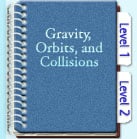 |
Keep a
Star Journal
Go outside on a starry night with a notebook, pencil, compass, and
flashlight. At the top of a page, write the date, time, place, and
weather conditions. Draw a circle at least 5 inches across to represent
everything you see in the night sky. Use your compass to determine
which direction is north and mark it on your circle. Draw in a few
landmarks you see on the horizon, like trees or buildings. Now look
straight up and look for familiar or distinct patterns of stars
in the night sky. Record what you see in your circle, using little
circles or dots to represent the stars. And don’t forget the
Moon if it’s out!
Twinkle, Twinkle
Did you know that stars don’t really “twinkle”?
They just look that way because we see them through the thick, moving
atmosphere surrounding our planet. You can see this for yourself
using water to represent the atmosphere. Crumple up a piece of aluminum
foil, and then flatten it out again. Next, cut out a few star shapes
from the foil and place them on a black sheet of construction paper.
Now place a shallow glass baking dish on top of the stars, filled
with about an inch of water. Turn off the lights and aim the flashlight
at the stars to make them “shine.” Tap the water with
your finger and watch the stars twinkle! Why does this happen? Just
like our moving atmosphere, the water keeps “bending”
the starlight in different directions. A mirage on a hot road and
sparkling light in a swimming pool are other examples of light bending.
Falling Meteorites
Ever wonder how a falling meteorite can create such a large and
unusual crater in the Earth? A meteorite can form a crater much
larger than the meteorite. Check it out for yourself. Fill a pan
with a layer of flour about one inch thick. Smooth the top to make
it flat. Then use a sifter to dust the surface with a thin coating
of cocoa powder, cinnamon, or another colored powder. Next, drop
a raisin from several inches above the pan. Try again in a different
spot, dropping the raisin from a few inches higher. Try a third
time, dropping the raisin from even higher. You could also try throwing
the raisin at the pan from an angle. Compare your different craters.
Look for different characteristics of actual meteorite craters,
like a raised rim around the hole, deeper material (flour) scattered
around the hole, or a pattern of lines radiating from the hole.
To experience more wonders of space, try out these cosmically cool
activities:
- Cosmic Cookies
Did you know Jupiter's Great Red Spot is really a 300-year-old hurricane that's twice as wide as Earth? Find out more awesome facts. Then celebrate your cosmic smarts with a solar system of cookies.
- Make a Moon Flip-book
The Moon is like a giant bike reflector in the sky, shining back light from the Sun. Sometimes you can see the whole reflector and other times just a thin wedge of it. To find out why, fill in a Moon Watch Log and turn it into a flip-book.
- Big Dipper Mobile
On Earth, the Big Dipper looks like a giant connect-the-dots puzzle page. Hundreds of light years away in space, though, you'd have a hard time recognizing the constellation. See why with a make-it-yourself mobile.
- Stargazing
There are thousands of visible stars in the night sky. Hidden among them are constellations and planets. How many can you find? Record your sightings in a stellar sky journal.
- Solar System Scavenger Hunt
Try this on for size: If Earth were the size of your head, then Mercury would be an orange and Jupiter a small car. Size up the planets for yourself with a model scavenger hunt.
|
 |



